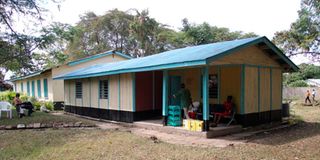Recovery centre brings hope to GBV victims in Homa Bay

The gender based violence recovery centre at Homa Bay County Teaching and Referral Hospital on November 23, 2021.
What you need to know:
- When a GBV case is reported, the staff at the centre first ascertain how the incident happened.
- Victims who cannot go back home are usually taken to safe spaces as their cases are being handled.
Before December 2020, sexual and gender-based violence (SGBV) victims who sought medical help from public hospitals in Homa Bay County, went back home (to the perpetrators) after being attended to.
No one from the hospitals really cared to find out what had happened or who had caused the injuries on their bodies.
At the outpatient department, men and women battered by their spouses, would walk in bleeding and the clinical officers would offer them first aid, prescribe drugs then release them to go home, the place where they got the injuries that took them to hospital.
At the peak of Covid-19, more victims visited health centres on multiple occasions after being attacked.
But it did not ring a bell in the minds of some health workers attending to them that a number of victims, mostly women, were silently suffering at home.
The cases escalated, to an alarming rate, when schools were closed as sex pests found easy prey on students at home.
Sexual rights
According to the Ministry of Interior, up to 7,000 cases of defilement were reported between March 2020 and October 2020.
Many women who visited the hospitals had their sexual rights abused. They were later discharged with no one offering them physiological or psychological support.
Those concerned about their wellbeing would later seek help from the police, with the hospital only getting involved if security officers asked for proof of sexual abuse.
Failure by medics in Homa Bay hospitals to seek answers on the suffering that women and girls go through meant that GBV cases were not addressed effectively.
The trend has, however, changed after a GBV recovery centre was established within one of the hospitals. The centre also serves as a mental recovery unit.
Since it opened its doors in December 2020, many people who found it hard to go back home after assault and treatment, have found hope.
Teenage girls
Many women have since shared their assault experiences while teenage girls who fall victims to sex pests are able to push for perpetrators’ arrest.
Anyone attacked at home is referred to the centre located within the hospital for psychological help.
Over the past 11 months, GBV victims have found solace at the centre, which was established by the county government of Homa Bay in collaboration with Nairobi Women Hospital and the Danish Family Planning Association.
Georgina Otieno, a psychiatric nurse at the centre, says the facility was established after concerned medics noticed a rise in GBV cases in the county, especially during the peak of Covid-19.
The centre was built at a secluded corner within the hospital, away from the eyes of the general public, to encourage more people to visit comfortably.
“Since opening, many women have confidently shared the abuse they experience at hands of their husbands,” Ms Otieno says.
The psychiatrist says GBV victims are usually advised on the best options, especially legal action to take.
Stigma
Up to 15 GBV cases are handled at the centre every month, with experts saying the cases could be more since not all victims report.
“It is unfortunate that men do not visit the centre. It is because of the stigma and traditional beliefs that men beaten by their wives are weak; so male victims fear being seen as such,” she says.
When a GBV case is reported, the five staff at the centre, including a physicist, physiologists and a general clinician first ascertain how the incident happened.
They then examine the victims to establish if they have any physical injuries to eliminate threats on their bodies.
Victims who cannot go back home are taken to the safe spaces, away from the suspects, while their cases are being handled.
“Cases involving children are reported to the police and children services department for legal action. Adults are also advised to seek legal action,” says Ms Otieno.
A number of humanitarian organisations have already offered legal help to GBV victims in Homa Bay County.
P3 forms
Priscila Ruto, a clinical physiologist at the centre, however, says some women prefer settling their cases through kangaroo courts, which makes it difficult to follow up the cases.
“We usually advise victims to come with their spouses, the suspects in GBV cases, in a bid to solve some cases amicably. Most victims, however, come alone. We are always ready to examine them and help them fill in P3 forms to assist police with investigations,” she says.
Ms Ruto adds that some cases become complicated when victims pursue justice, but do not have witnesses.
A recent case was of an expectant woman who walked to the centre after allegedly being attacked by her landlord.
When she asked the police to initiate legal action against the landlord, she was told the case could not proceed because the witnesses were not ready to testify.
“It turned out that the landlord threatened all his tenants and nobody was willing to report his deeds,” Ms Ruto says.
Not all is gloomy though as they have had successful cases where GBV victims got justice.
Ms Ruto says a defilement suspect was recently convicted to 25 years in prison for sexually abusing a primary school pupil.
“We follow up on all cases with the help of social workers and the police. Our mission is to end GBV,” she says.
The centre currently operates during the day from 8am to 5pm.





